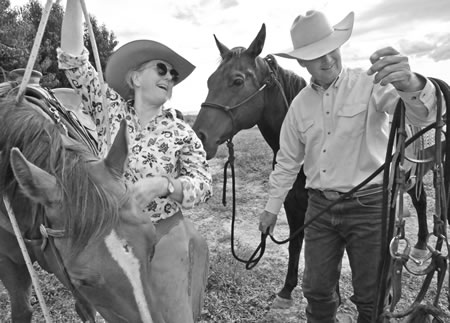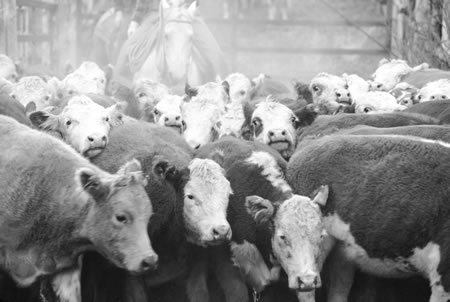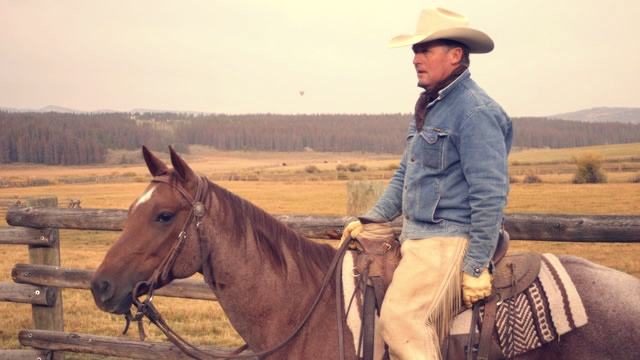Written by Patti Hudson Photos by Eric Sines
This article originally appeared in Eclectic Horseman Issue No.71
I had just finished shoeing my horse, and was unkinking my back, when the dog jumped off the haystack where he’d been hunting packrats and landed on a pile of tarps.
 The horse had a big issue with tarps and flags, and pretty much anything that flapped or crinkled. He came to me with this problem, but in the time I had owned him I hadn’t helped him much. Mainly he and I had been surviving by avoidance. I knew the problem wasn’t going to fix itself. I was just afraid that in trying to fix it I would make it worse.
The horse had a big issue with tarps and flags, and pretty much anything that flapped or crinkled. He came to me with this problem, but in the time I had owned him I hadn’t helped him much. Mainly he and I had been surviving by avoidance. I knew the problem wasn’t going to fix itself. I was just afraid that in trying to fix it I would make it worse.
Then when the dog hit those tarps and things went sideways, my tools scattered everywhere, my horse in a panic I knew I had to put aside my own worries and do something to finally help him. I had an article I was supposed to be working on with Joe Wolter for Eclectic Horseman. Spring was finally here and there were plenty of other chores to do. I had a lot of day work coming up and story deadlines and schedules to keep. Even though my living revolves around horses, like everyone else, I have to juggle the time I actually get to spend with my horses against all the other demands and distractions of everyday life.
For the sake of this horse, I had to finally put aside everything else—including my own worries about making a mistake and overdoing it. Joe would understand if we didn’t get to the story for a few days, and I was pretty sure Emily would too. I stretched out a tarp in the barnyard and started thinking about some things Joe had talked about in clinics the year before, when we had worked on crossing a bridge and how he had stressed the importance of getting our horses lined up and ready to cross. It wasn’t about getting across the bridge; it was about getting ready to cross the bridge.
So I put crossing the tarp out of my mind and I decided I would settle for the horse just getting himself lined up in a position that he could cross it once he was able to make that choice. But even that proved difficult. Using just the end of my lead rope to help direct and encourage didn’t get me any further than I had ever gotten with this horse. Then I remembered something Joe had recently said when we were tossing around article ideas, “If the same thing keeps happening you have to change.”
I took a chance and grabbed a flag, which sure enough got the horse’s attention. Now he was faced with the two most frightening things he could imagine. Was I doing too much? Was I going to overexpose him? I didn’t know. I just knew if I didn’t do something different he and I would forever be riding in fear, always on the lookout for the next thing to crinkle or flap in the breeze.
 He was afraid of the flag, but less so as I began using it with a purpose in mind, helping him to get straight and ready, and then taking the pressure off as soon as he got himself prepared to cross the tarp. From there it didn’t take too much to get the rest. It seemed to me that straightness was the key. If I could help him find that spot where he was straight, he got so he would come right across that terrifying tarp, real quiet and easy, but if I let him drift off, he got troubled again.
He was afraid of the flag, but less so as I began using it with a purpose in mind, helping him to get straight and ready, and then taking the pressure off as soon as he got himself prepared to cross the tarp. From there it didn’t take too much to get the rest. It seemed to me that straightness was the key. If I could help him find that spot where he was straight, he got so he would come right across that terrifying tarp, real quiet and easy, but if I let him drift off, he got troubled again.
The next day I had to go help ship cattle. The corrals were a mess of snow and ice and mud. The cattle were a mix of everything—dry cows, bulls, yearlings and a few cows and calves. The regular ranch hands had done very little in preparation. Gates weren’t functioning. The loading chute was like a bobsled run and pretty quick everyone was in a foul mood—especially the bulls. At one point I was handed a flag to help try and move things along. I wasn’t sure how my horse would take it, but the preparation I had done the day before paid off. It was the first time I had ever been able to ride that horse with a flag in my hand. Not only did it save him a lot of work, it allowed me to protect us both from some very unhappy animals and get through a bad situation all the better for having done it.
I called Joe as soon as I got home and told him about the last couple of days, how the flag had gone from something my horse thought would eat him to something he understood could help him. He wasn’t just tolerating it; he was embracing it. I wasn’t sure exactly how I had done it, but I thought it had something to do with finding straightness and that it might be something good for us to talk about in an article.
“Maybe,” he said. “But the straightness was just a byproduct of his idea being your idea.”
“So what was it I did?”
And typical of Joe, the answer wasn’t nearly as complicated as I wanted to make it. “You didn’t approach it like it was about the flag,” he said. “You put two things together at the same time. His self-preservation with the flag helped him with the other.”
 He went on to explain how he had been at a branding once with Tom Dorrance. “My horse was really troubled, so rather than directing her with my reins, Tom had me use my coils. Instead of working on one thing and making it the issue, we added something else to the mix and pretty soon I had a float in my reins and a nice quiet horse.”
He went on to explain how he had been at a branding once with Tom Dorrance. “My horse was really troubled, so rather than directing her with my reins, Tom had me use my coils. Instead of working on one thing and making it the issue, we added something else to the mix and pretty soon I had a float in my reins and a nice quiet horse.”
“So is that straightness?” I asked. I was really trying to find a hook for this article we needed to work on.
“Straightness is just you and the horse going the same place and it not weighing anything.”
“So let’s write about that,” I said.
“We just did,” Joe said. “It’s all right there in what you told me about your horse.”
This article originally appeared in Eclectic Horseman Issue No.71
https://eclectic-horseman.com/mercantile/special-sets/the-horsemans-gazette-issues-no-05-08/


